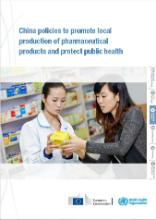Published by: Geneva: World Health Organization; 2017
Download here
China has a very substantial local pharmaceutical manufacturing sector and capacity. That manufacturing sector developed during a period of China’s relative isolation from international trade, particularly with respect to high-income Western countries. The industry was state-owned and the Government provided significant incentives for development, including establishing special industrial zones that included provision for low-cost land purchase and infrastructure development. As China opened its economy in the late 1980s, and joined the World Trade Organization (WTO) in late 2001, it transitioned to a largely market-based economy.
This transition witnessed a period of rapid economic growth, including for China’s local pharmaceutical industry. That industry largely focused on production of basic chemicals and active pharmaceutical ingredients (APIs), and China has emerged as the leading supplier of APIs by volume to the global market. Although China’s API manufacturers are major exporters, so far exports of finished pharmaceutical products (FPPs) are less significant. Traditional Chinese medicines (TCM) are a significant component of the Chinese domestic pharmaceutical market, and the Government is promoting TCM as an export opportunity.
The rapid growth of China’s pharmaceutical manufacturing sector over the past 30 years was not accompanied by an equally robust development of the medicines regulatory framework. Recognizing this, China is today emphasizing the strengthening of that framework, both in terms of rule-making and addition of personnel. This process of regulatory strengthening necessarily takes some time. A number of smaller and medium-sized pharmaceutical companies may not be able to finance compliance with new rules requiring retrofitting and/or building new pharmaceutical manufacturing facilities.
China has in place intellectual property laws that are compliant with the WTO Agreement on Trade-Related Aspects of Intellectual Property Rights (TRIPS), including implementation of available flexibilities. While some foreign governments and their industries have voiced concerns about China’s enforcement of intellectual property (IP) rules, this does not appear to have had a significant effect on the flow of investment into China.
From the WHO standpoint, the single most important aspect of China’s current policy with respect to the pharmaceutical sector is its close linkage to the objective of universal health care (UHC). UHC is a key priority for the China Government, which has committed to providing access to medicines for its people. Pharmaceuticals account for a substantial part of the current China health care budget. To achieve and sustain UHC, pharmaceutical supply must be undertaken in a way that is affordable, notwithstanding the fairly substantial financial resources of China. China has a population of approximately 1.4 billion people, and it is a population that is rapidly aging. This will increase demand for pharmaceuticals, and place increasing burden on the health care budget and system as a whole.
Keywords: China, pharmaceuticals, production, API, regulation, environment, universal healthcare, WTO
JEL Classification: H25,H51,I18,I25,L65,030

